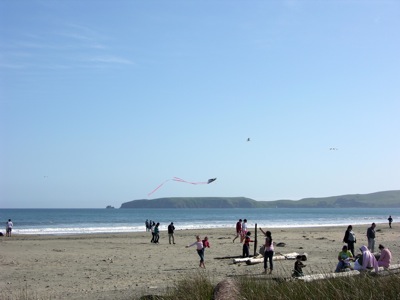
Courtesy NPS
The National Park Service has been called “America’s best idea,” and many of the most famous parks have captivated American vacationers for generations. In addition to natural wonders like Yellowstone and the Grand Canyon, the park service preserves some of the most pristine stretches of ocean coastline in the United States.
Visitors can explore rocky cliffs, grassy dunes and miles of undisturbed beaches at the country’s 10 national seashores. Besides swimming, sunbathing and other traditional beach activities, groups that stop at a national seashore can take part in ranger-guided tours and other programs that shed light on the area’s history, culture and wildlife.
Soft-adventure and ecotourism opportunities abound as well, giving travelers a chance to experience some of nature’s seaside splendors firsthand.
Here are some examples — one from each coast — of what your group will find when visiting America’s national seashores.
Cape Cod National Seashore
Massachusetts
New England’s favorite vacation destination, Cape Cod, comprises nearly 560 miles of beaches. The Cape Cod National Seashore preserves the very best of this Atlantic beach destination.
“The national seashore is where our best beaches are,” said Kristen Mitchell, vice president of marketing for the Cape Cod Convention and Visitors Bureau. “John F. Kennedy actually signed the law when he was president, so they’re celebrating their 50th anniversary this year. It’s 40 miles, and it’s not just beaches — there are lighthouses, cranberry bogs and biking trails.”
Beachgoing may be the most popular activity at the seashore, but it is by no means the only one. Rangers offer numerous guided tours and scheduled activities at different places around the park. Visitors can also explore on their own or take guided kayaking excursions through the marshes, inlets, kettle ponds and bays along the cape.
One of the most popular spots on kayaking tours is Nauset Marsh.
“Nauset Marsh is a large salt marsh within the national seashore,” Mitchell said. “It’s protected from the ocean by the beaches, so anyone can paddle fine on it. The scenery is unbelievable — you can see shorebirds and seals, and there are sandbars. It’s Cape Cod at its finest.”
For a more leisurely experience, sightseeing cruises give groups glimpses of some of the lighthouses, cranberry bogs and other notable features that dot the national seashore. Some of these cruises include traditional New England clambakes in addition to the narration.
Groups visiting Cape Cod should also plan to take a whale-watching excursion, where they’re likely to find baleen, minke and white whales. Many tour itineraries also include visits to Nantucket or Martha’s Vineyard, both of which are accessible by ferry from the Cape.
Padre Island National Seashore
Texas
On the Gulf of Mexico, America’s third coast, Padre Island National Seashore stretches along a narrow island just off of the south coast of Texas.
“We have over 70 miles of beaches and dunes,” said Juan Rodriguez, chief of interpretation at the national seashore. “It’s the largest undeveloped seashore in the United States. Twelve miles north of us is the developed area of Padre Island.”
In addition to the Gulf Coast, the national seashore protects the coastal prairie and tidal flats in an area known as the Laguna Madre. The hypersaline lagoon has a high concentration of salt, making it an ideal fishing area. Visitors who go on fishing excursions often return with trout, black drum and even sharks.
The area is also home to a rare type of sea turtle.
“We protect an endangered species of marine turtles called Kemp’s ridley,” Rodriguez said. “The turtle has come back from the brink of extinction.
“They start nesting around mid-April, and we have public turtle releases throughout the summer. This year, we had 199 nests and have already had 29 public releases.”
Avian enthusiasts will also find animals to get excited about at the seashore. The area sees more than 380 species of birds each year, including whitetail hawk and peregrine falcons that stop over on their way from Alaska to Argentina.
Padre Island also enjoys a long cultural history. The area was first occupied by Europeans in 1554, when three Spanish ships ran aground on the island. After a period of colonization and evangelization of the native people, cattle ranching became popular. Visitors can learn about the shipwreck and the clash of cultures on the island at museums in Corpus Christi.
Point Reyes
National Seashore
California
About an hour’s drive from the Golden Gate Bridge, Point Reyes National Seashore preserves a rugged, rocky section of California’s Pacific coast.
“We’re the only national seashore on the West Coast,” said park spokesman John Golda. “We have over 100 square miles here, and a large portion of it is wilderness area.
“We have an amazing tapestry of resources, from big rocky cliffs and lighthouses to coastal prairies and grassland. There are huge expanses of sandy beach, as well as steep mountains covered with fir and pine.”
A visit to Point Reyes affords the opportunity to view many types of wildlife. During the winter months, gray whales migrate through the area; park rangers have spotted up to 200 whales in one day.
Elephant seals, which can grow to 5,000 pounds and 18 feet long, breed in the area during the winter as well.
The park is also home to about 500 head of tule elk, a threatened species that was driven to near extinction during the 1840s gold rush. Today, the park’s herd is the third-largest in the nation.
Visitors will also find abundant marine life in the tidal pools on the seashore.
“The tidal pools are pretty amazing,” Golda said. “You’ll find animals living on top of other animals and plants living on top of them. During the winter months, we get great low tides, so you see all the rocky layers that are normally covered with water. It’s like walking through an aquarium.”
Groups can take kayaking tours of the park’s Tomales Bay or visit an 1870 lighthouse. Some 150 miles of hiking trails offer opportunities for individual exploration.
Ranger-led tours highlight the lighthouse, local Native American heritage and the impact of the 1906 San Francisco earthquake.
www.nps.gov/pore











